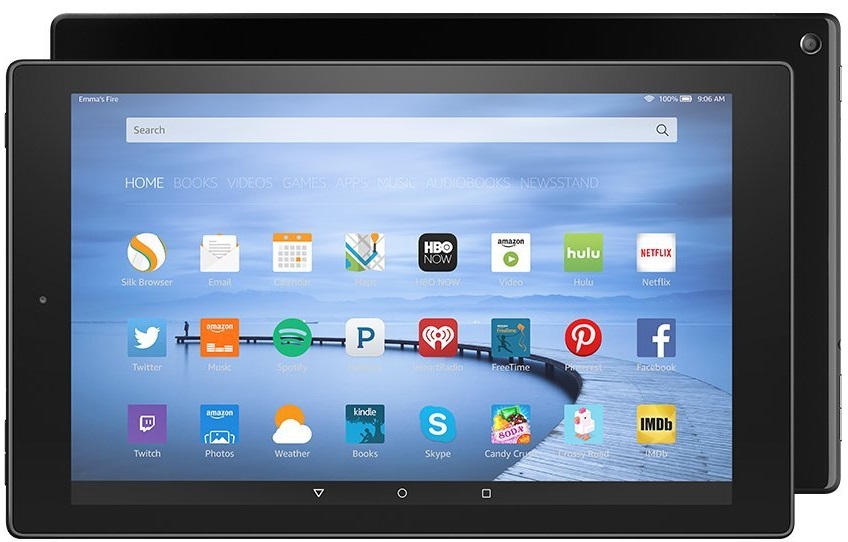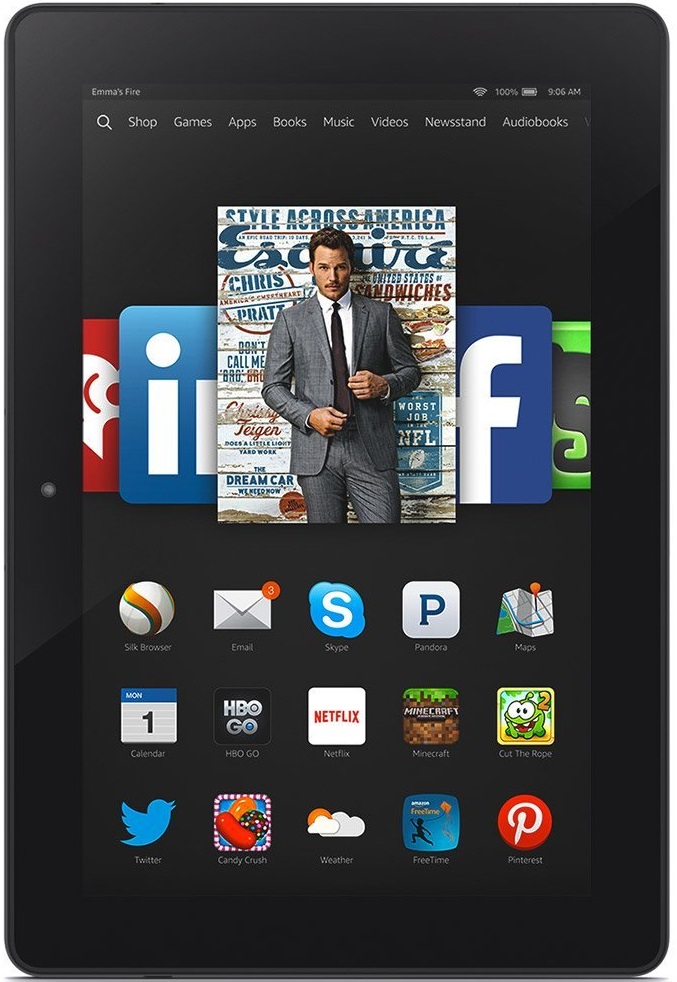Computer Tablets – Part II
By Wayne Maruna
Last
month’s Taberna Tribune computer article provided an overview of
tablets and mentioned there were four primary tablet operating
systems. This month, I will focus on the Amazon Fire OS
(Operating System), which is a highly customized version of Google’s
Android operating system that also powers many of today’s smart phones.
Whereas Google’s Android system is the basis for many different
brands of tablets, including Asus, Dell, Lenovo, Samsung, and Sony,
Amazon’s Fire OS is unique to Amazon’s own devices. Amazon tablet
models change almost yearly. Currently their offerings include
the Fire HD 6, Fire 7, Fire HD 8, and Fire HD 10. The numbers
correspond with the diagonal screen measurement within a tenth of an
inch. Prices start at $50 for the 7, $70 for the 6 (more because
it has a higher resolution screen), $150 for the 8, and $230 for the
10. The starting prices include 8GB of storage on all but the 10
which starts at 16GB, and all can and should be upgraded.
Starting prices also include ‘Special Offers’ which is a euphemistic
term for ads contained in the tablets’ lock screens. You can hand
Amazon an additional $15 to remove the ads from any of the tablets.
Program applications are obtained through the Amazon App
Store. Despite the Android underpinnings, Amazon locks their
tablets out of the Google Play Store (Google’s name for their app
store.) Amazon has fewer apps available, and if you are used to
certain apps on your Android phone or tablet, you may be frustrated by
their lack of availability in the Amazon store, most notably the Google
Chrome browser (Amazon wants you to use their unique ‘Silk’ browser).
The Fire tablets have been scaled back, hardware wise, in their
2015-2016 versions, meaning less RAM, slower processors, and lower
screen resolutions. I assume this was done to reduce costs in
order to lower the selling price. Amazon wants to get these into
users’ hands so they can entice them to purchase more content (books,
movies, music, games), and there is a lot of in-your-face emphasis on
this.
The current version 5.0 of Fire OS is
called Bellini. To Amazon’s credit, they have also made the
latest version available for update to their 2014 models. Bellini
displays app icons in a matrix format similar to the iPad and Android
tablets, replacing the former revolving carousel approach. As a
person accustomed to the Apple and Android formats, this is a welcome
change.
Below are comments based on my
personal experience with two Fire tablets, the current top-of-the-line
Fire 10, and the former top-of-the-line 2014 model, Fire HDX 8.9.
Amazon Fire HD 10

The
specs: a 10.1” screen (measured diagonally), 8.5” wide and 5.3” high
for a total screen surface of 45.05 sq. inches, fractionally more than
the iPad Air. Its weight of 15.24 ounces is a couple of eyelashes
less than the iPad. Unlike the iPad’s 4:3 width to height ratio,
it has a wide-screen 16:10 ratio common to all current Fire
offerings, but its large size makes the width to height ratio
even more pronounced. Where the Fire 10 falls short is in pixel density
at only 149 ppi (pixels per inch, compared to the iPad’s 264).
Additionally, the Fire 10 comes with only 1GB of RAM compared to 2GB in
both the iPad Air 2 and Amazon’s 2014 Fire HDX 8.9. Storage is
available in 16 or 32GB size, but you can expand storage with up to a
128GB Micro SD memory card, and Amazon offers free unlimited cloud
storage for all Amazon content. The Fire 10 is Wi-Fi only, no cellular
option.
The experience: The low pixel density is evident if one
is accustomed to a better screen, but it’s not terrible. If this were
your first and only tablet you would likely not notice it. Videos
look decent and the speakers sound good as well. But with only
1GB of system memory and the choice of a lesser CPU, there is
noticeable system lag when opening apps or switching from one to
another. Wireless connectivity was also a bit of an issue from
time to time. The large size and aspect ratio also make it less
comfortable to hold in portrait mode for any length of time. The 32GB
model was on sale in early 2016 for $210, which made it a steal
compared to the iPad if one primarily wants to read books or watch
movies. Amazon Prime members get access to Amazon Underground
with its $20K worth of free apps and games. The Fire 10’s best use
might be for watching movies.
Amazon Fire HDX 8.9
 Amazon
still offers the Fire HDX 8.9 new at prices around $400, but used
models show up regularly on Amazon and eBay. The last model was the
2014 version, and it is a very good tablet. The 64GB model I tested for
this comparison was purchased used on eBay for a fraction of its
original price, and arrived looking brand new. Everything the Fire 10
lacks – speed, consistent connectivity, and screen clarity – the HDX
8.9 has. Its 339 ppi density is among the highest available and it
shows. With 2GB of RAM and a 2.5 GHz processor, everything is clear and
snappy. Amazon makes its latest Fire OS 5.0 (Bellini) update available
to the 2014 but not the 2013 model. Its square inch screen size (16:10
ratio) is 19% smaller than that of the iPad, but at 13.2 ounces it is
also a couple ounces lighter. The limited Amazon app store and lack of
an SD card expansion slot are its only downsides.
Amazon
still offers the Fire HDX 8.9 new at prices around $400, but used
models show up regularly on Amazon and eBay. The last model was the
2014 version, and it is a very good tablet. The 64GB model I tested for
this comparison was purchased used on eBay for a fraction of its
original price, and arrived looking brand new. Everything the Fire 10
lacks – speed, consistent connectivity, and screen clarity – the HDX
8.9 has. Its 339 ppi density is among the highest available and it
shows. With 2GB of RAM and a 2.5 GHz processor, everything is clear and
snappy. Amazon makes its latest Fire OS 5.0 (Bellini) update available
to the 2014 but not the 2013 model. Its square inch screen size (16:10
ratio) is 19% smaller than that of the iPad, but at 13.2 ounces it is
also a couple ounces lighter. The limited Amazon app store and lack of
an SD card expansion slot are its only downsides.
Next month I will detail my impressions of the iPad and Apple app store, along with a Google Nexus and its Google Play Store.

 Amazon
still offers the Fire HDX 8.9 new at prices around $400, but used
models show up regularly on Amazon and eBay. The last model was the
2014 version, and it is a very good tablet. The 64GB model I tested for
this comparison was purchased used on eBay for a fraction of its
original price, and arrived looking brand new. Everything the Fire 10
lacks – speed, consistent connectivity, and screen clarity – the HDX
8.9 has. Its 339 ppi density is among the highest available and it
shows. With 2GB of RAM and a 2.5 GHz processor, everything is clear and
snappy. Amazon makes its latest Fire OS 5.0 (Bellini) update available
to the 2014 but not the 2013 model. Its square inch screen size (16:10
ratio) is 19% smaller than that of the iPad, but at 13.2 ounces it is
also a couple ounces lighter. The limited Amazon app store and lack of
an SD card expansion slot are its only downsides.
Amazon
still offers the Fire HDX 8.9 new at prices around $400, but used
models show up regularly on Amazon and eBay. The last model was the
2014 version, and it is a very good tablet. The 64GB model I tested for
this comparison was purchased used on eBay for a fraction of its
original price, and arrived looking brand new. Everything the Fire 10
lacks – speed, consistent connectivity, and screen clarity – the HDX
8.9 has. Its 339 ppi density is among the highest available and it
shows. With 2GB of RAM and a 2.5 GHz processor, everything is clear and
snappy. Amazon makes its latest Fire OS 5.0 (Bellini) update available
to the 2014 but not the 2013 model. Its square inch screen size (16:10
ratio) is 19% smaller than that of the iPad, but at 13.2 ounces it is
also a couple ounces lighter. The limited Amazon app store and lack of
an SD card expansion slot are its only downsides.